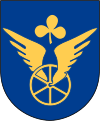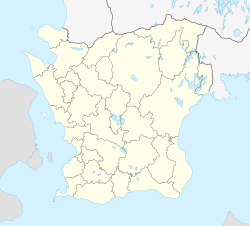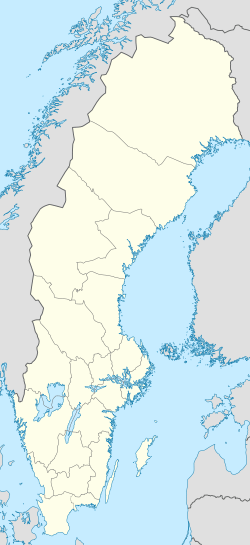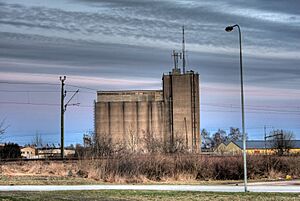Eslöv facts for kids
Quick facts for kids
Eslöv, Sweden
|
||
|---|---|---|
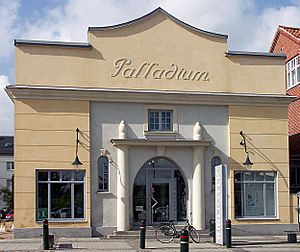
Eslöv Municipal Library
|
||
|
||
| Country | Sweden | |
| Province | Skåne | |
| County | Skåne County | |
| Municipality | Eslöv Municipality | |
| Founded | 1911 | |
| Area | ||
| • Total | 9.14 km2 (3.53 sq mi) | |
| Elevation | 68 m (223 ft) | |
| Population
(31 December 2018)
|
||
| • Total | 17,748 | |
| • Density | 1,942/km2 (5,030/sq mi) | |
| Time zone | UTC+1 (CET) | |
| • Summer (DST) | UTC+2 (CEST) | |
| Postal code |
241 xx
|
|
| Area code(s) | (+46) 413 | |
Eslöv is a town in Sweden. It is located in Skåne County and is the main town of Eslöv Municipality. In 2018, about 19,598 people lived here. Eslöv is also part of the larger Öresund region, which includes parts of Sweden and Denmark.
Contents
A Look Back: Eslöv's History
Eslöv started as a small village. A map from 1717 shows it was near where Västergatan and Remmarlövsvägen meet today. The town really began to grow when the main railway line was built through it.
How Railways Helped Eslöv Grow
The first trains passed through Eslöv on October 4, 1858. This railway connected big cities like Stockholm and Malmö. Soon, more railway lines were added. In 1865, a line to Landskrona and Helsingborg opened. A year later, a line to Ystad started.
Eslöv quickly became an important railway hub. This meant more trade and business came to the town. Later, more railways opened, connecting Eslöv to places like Hörby and Kristianstad, and also to Röstånga and Klippan.
Keeping People Healthy: Healthcare in Eslöv
Eslöv got its first doctor, Walter Ström, in 1865. A pharmacy opened in 1870. Later, in 1942, a dental clinic and a place for child care were set up. In 1969, a new emergency medical center opened. Another health center, Kärråkra, was built in 1985.
Modern Services: Water, Gas, and Electricity
The first telephone lines came to Eslöv in 1884. By the end of that year, 30 people had phones! In 1905, the town got a water tower and a gas plant. The gas plant was later closed in the 1950s. A new, bigger water tower opened in 1968.
Eslöv is part of a group of cities that get their water from Lake Bolmen. The water travels through an 80-kilometer-long tunnel! It then goes to a water treatment plant to be cleaned before it reaches homes.
In 1909, Eslöv built a plant to clean wastewater. The town also started looking into electricity. By 1911, the first electricity station was ready. In the 1920s, gas lamps in Eslöv were replaced with electric lights.
The town bought its first fire engine in 1920. By 1925, Eslöv had its own professional fire service. In 1985, a system for heating homes and buildings from a central source, called district heating, was built.
Eslöv's Local Government and Growth
Eslöv started as a village. Over time, it grew and changed its local government status. In 1875, it became a "market town" (köping). On January 1, 1911, Eslöv officially became a city. The city continued to grow by adding nearby areas.
The Eslöv Airport (ESME) is a local airstrip. It was first used for mail and military training during World War II. Today, it is mostly used by private pilots and people who enjoy parachuting.
Making Things: Industry and Business in Eslöv
Eslöv has a long history of different industries and businesses.
Banking in Eslöv
Eslöv's Savings Bank was started in 1866. It later merged with other banks, becoming part of Sparbanken Finn.
Major Companies in Eslöv Today
Several big companies have operations in Eslöv, including:
- Dr Pers Food AB
- Orkla Foods Sweden (known for Felix products)
- Saint-Gobain Sekurit AB (makes glass)
- Smurfit Kappa Sverige AB (makes packaging)
- Cygrids Communications AB (a tech company)
Eslöv's Industrial Past
In the past, Eslöv was a busy place for trading grain. In the 1870s, the town had breweries, bakeries, and workshops. Some of the first official industries included a wool factory, a foundry, a tannery, and a vinegar factory. These early businesses employed about 40 people.
Grain and Wood Products
In 1865, Carl Engström started a company that became one of the largest in southern Sweden for grain, seeds, and farm machinery. Another important company, AB Nils Johnson & Co, started in 1868. It first dealt with flour and feed. Later, it grew to include a carpentry factory and other wood-related businesses. Today, this company is known as Optimera.
Textile Industry
Eslöv had several textile factories. Renck's wool factory, started in 1869, made felt blankets. It was destroyed in a fire in 1898. Carl Peter Sahlin started a dyeing business in 1879. His son, Albert Sahlin, later founded Sahlins Konfektion AB, which was famous for making children's clothing. This factory closed in 1973.
Eslövs Yllefabrik, founded in 1905, was unique because it had machines to print colors on fabric. It closed in 1959. Another company, La Reine, started in 1939 and made coats and rainwear.
Metal Industry
The Ljungbergska Foundry was an early metal business. In 1889, Lars Åkerman bought it and renamed it Åkermans Gjuteri and Mekaniska Verkstad. In the 1920s, they made road rollers. From 1939, Åkermans started making excavators, which are digging machines. These excavators became famous worldwide. The company later became Volvo Excavator. Sadly, in 1998, Volvo decided to stop making excavators in Eslöv.
What Makes Eslöv Special
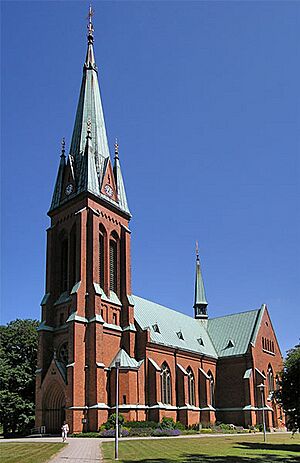
Eslöv is home to Lagerhuset, which is Sweden's tallest wooden house. It was built as a grain silo during World War I. In 2007, it was renovated and turned into apartments.
The medicine Salubrin was invented in Eslöv. Also, several other large companies have their main offices in the town.
Some famous people were born or grew up in Eslöv, including:
- The Swedish comedian Johan Glans.
- The professional golfer Ludvig Åberg.
Sports in Eslöv
Eslöv has several sports clubs:
- Eslövs AI – This club has won national championships in table tennis and wrestling.
- Eslövs BK
Eslövs Motorstadion was a motorcycle speedway track that existed from 1948 to 1961. It even hosted a qualifying round for the Speedway World Championship in 1953.


